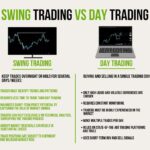Introduction
Day trading is a fast-paced trading style where positions are opened and closed within the same trading day. Unlike long-term investing, day traders capitalize on small price movements in highly liquid markets. While it can be exciting and potentially profitable, it also comes with significant risks—especially for beginners. This guide will provide a comprehensive overview of day trading strategies tailored for those just starting their journey.
What is Day Trading?
Day trading involves buying and selling financial instruments—such as stocks, forex, cryptocurrencies, or commodities—within the same day. The goal is to profit from short-term price fluctuations rather than long-term trends.
Key Characteristics:
- No positions held overnight.
- High trade frequency.
- Relies on market volatility and liquidity.
- Requires constant monitoring of the markets.
Tools Required for Day Trading
Before diving into strategies, you need the right setup:
- Trading platform: A fast, reliable platform with real-time charting tools.
- Broker account: Choose a broker with low spreads, fast execution, and low latency.
- News feed: Economic and political news often influence short-term prices.
- Technical indicators: Used for timing entries and exits.
Basic Day Trading Strategies
Here are some of the most popular and beginner-friendly day trading strategies:
1. Momentum Trading
This strategy focuses on assets that are moving significantly in one direction, often triggered by news, earnings reports, or strong technical setups.
How it works:
- Identify a stock or currency pair with unusual volume and strong price movement.
- Enter in the direction of momentum (upward or downward).
- Use tight stop-losses and ride the trend until signs of weakness appear.
Best for: Beginners who can react quickly and manage risk properly.
2. Breakout Trading
This strategy involves entering a trade when the price moves beyond a key support or resistance level with increased volume.
Steps:
- Identify major support and resistance levels on the chart.
- Wait for a confirmed breakout (preferably with volume).
- Enter the trade and place a stop-loss just outside the broken level.
Warning: Avoid false breakouts by confirming with volume or waiting for a retest.
3. Reversal (Pullback) Trading
This strategy aims to catch turning points in the market after a strong move.
How it works:
- Look for overextended price moves using indicators like RSI or Stochastic.
- Enter against the trend once reversal patterns form (e.g., double top/bottom, pin bars).
- Use tight risk control, as reversals can fail.
Note: This strategy requires good timing and is riskier for beginners.
4. Scalping
Scalping involves making dozens (or even hundreds) of small trades throughout the day, targeting tiny price movements.
Key features:
- Trades last from seconds to minutes.
- Focus on high liquidity assets like EUR/USD or large-cap stocks.
- Requires ultra-fast execution and low transaction costs.
Not ideal for: Beginners without experience in managing rapid trades.
Risk Management in Day Trading
Day trading without a solid risk management plan is financial suicide. Here are core principles:
- Use stop-loss orders: Always define your risk before entering a trade.
- Risk only 1-2% per trade: Preserve capital by limiting your exposure.
- Have a daily loss limit: Stop trading if your loss limit is hit.
- Avoid overtrading: Stick to high-probability setups.
Psychology of a Day Trader
Trading psychology is just as important as strategy.
- Discipline: Stick to your plan and avoid emotional decisions.
- Patience: Wait for clear setups rather than forcing trades.
- Confidence: Comes from practice and following your strategy.
Beginners often make the mistake of chasing the market or trying to recover losses emotionally, which leads to further losses.
Common Mistakes to Avoid
- Trading without a plan: Jumping into trades based on feelings or tips.
- Ignoring risk management: Taking oversized positions with no stop-loss.
- Revenge trading: Trying to win back losses in a rush.
- Overtrading: Trading too frequently without high-quality setups.
- Not reviewing trades: Failing to learn from past mistakes.
Sample Day Trading Plan for Beginners
Asset: EUR/USD
Strategy: Breakout
Indicators: 20 EMA, RSI
Entry rule: Buy on breakout of resistance with RSI > 50
Stop-loss: 15 pips below breakout
Take-profit: 30 pips (risk:reward 1:2)
Session: London Open to New York Lunch
Having a clear and repeatable plan reduces stress and improves results over time.
Best Timeframes for Day Trading
- 1-minute and 5-minute charts: For scalping and ultra-short trades.
- 15-minute and 30-minute charts: Most common for beginners.
- Hourly charts: For more patient, higher-quality setups.
Final Tips for New Day Traders
- Start with a demo account until you’re consistent.
- Trade only with capital you can afford to lose.
- Track every trade in a journal for analysis.
- Focus on one or two markets—don’t try to master everything at once.
- Keep it simple. A few strategies done well outperform a dozen done poorly.
Conclusion
Day trading offers the potential for profits, flexibility, and excitement—but it also demands preparation, discipline, and continuous learning. As a beginner, focus on mastering one or two strategies, managing risk, and building emotional resilience. Over time, with practice and consistency, you can become a skilled day trader with the tools to succeed in any market condition.


